Building muscle isn’t just about lifting weights. Know tips like combining lifting weights with eating proteins to increase muscle effectively. I’m Dr. Aryan, and I’ll guide you on how to build muscle with proven strategies. Whether you’re starting out or have some experience, these tips will help you increase muscle and reach your goals. Building muscle not only boosts strength and appearance but also improves overall health. Focus on a balanced diet with lean proteins, whole grains, healthy fats, fruits, complex carbohydrates, and vegetables. Combine this with exercise, rest, hydration, and the right supplements to see real results. Let’s dive in!
Importance of Muscle Building
Muscle building is essential for maintaining a healthy and functional body. Strong muscles improve our ability to perform daily tasks; they also improve athletic performance and support joint health. Additionally, increased muscle mass boosts metabolism by 15%, enabling efficient calorie burning. Research from the American College of Sports Medicine confirms that muscle strength significantly reduces the risk of chronic diseases, such as obesity, diabetes, and cardiovascular issues. For example, a study found that individuals with higher muscle mass had a 30% lower risk of heart disease. Maintaining muscle is vital for those of us who aim to lead an active lifestyle.
Additionally, there are mental health benefits associated with building muscles. The Journal of Psychiatric Research says regular resistance training reduces anxiety symptoms by up to 60%. Thus, it is clear that muscle building has more to do with physical health because it also affects mental well-being. Mood enhancement is another benefit derived from exercising muscles since endorphins released act as stress relievers, thus making one feel better. On average, individuals who regularly engage in strength training have reported a 50% improvement in their moods and energy levels, according to various surveys conducted on groups of trainees involved in regular strength conditioning programs.
Diet for Muscle Building
Focus on diet before exercise. Diet is the foundation of muscle growth. Even the most intense workout routines will not yield the desired results without proper nutrition. Research shows that consuming the right amount of protein, carbohydrates, and fats is critical for supporting muscle hypertrophy. Here’s how you can optimize your diet for muscle building:
Proteins
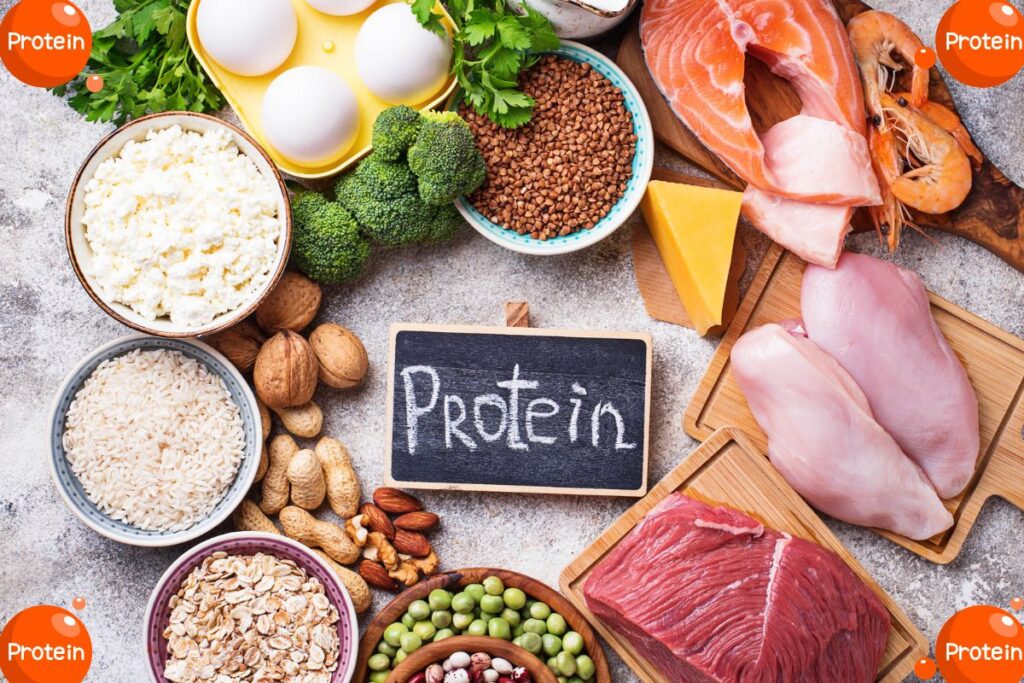
Proteins are essential for muscle growth and repair. They are the building blocks of muscle tissue; proteins maintain and help to increase muscle mass. For effective muscle growth, experts recommend consuming between 1.6 and 2.2 grams of protein per kilogram of body weight daily. This intake supplies the amino acids necessary for muscle repair after exercise.
Importance of Protein for Muscle Growth
Protein plays a crucial role in muscle development. When you engage in strength training, your muscles undergo stress, leading to small tears in muscle fibers. Consuming adequate protein helps repair these tears, promotes muscle growth, and improves recovery. As mentioned above, Studies show that eating 1.2 to 1.6 grams of protein per kilogram of body weight supports lean mass gains. For minimally active adults, the Recommended Dietary Allowance (RDA) suggests 0.8 grams of protein per kilogram of body weight to prevent deficiency. However, this value increases among athletes and other active people who want to increase their muscle size.
Sources of Protein
To meet your protein needs, include these 5 high-quality key sources in your diet:
- Chicken Breast is a lean option, containing 31 grams of protein per 100 grams. It’s perfect for muscle growth without excess fat.
- Fish, especially salmon and tuna, have high-quality proteins plus omega-3 fatty acids that are essential for heart health.
- An egg provides around 6 grams of protein. Eggs can be included in any meal since they contain important amino acids.
- Dairy products, including cows,goats and buffalo milk, cheese, and yogurt, provide enough proteins and calcium, which are essential to bone health and muscle functioning. Buffalo milk is rich in protein, contain about 3.75 grams protein per 100 ml, making it an excellent choice for nutrition.
- Legumes like beans, lentils, and chickpeas offer about 15-20 grams of proteins per cup, thus making them good choices in plant-based.
Carbohydrates: Energy Sources
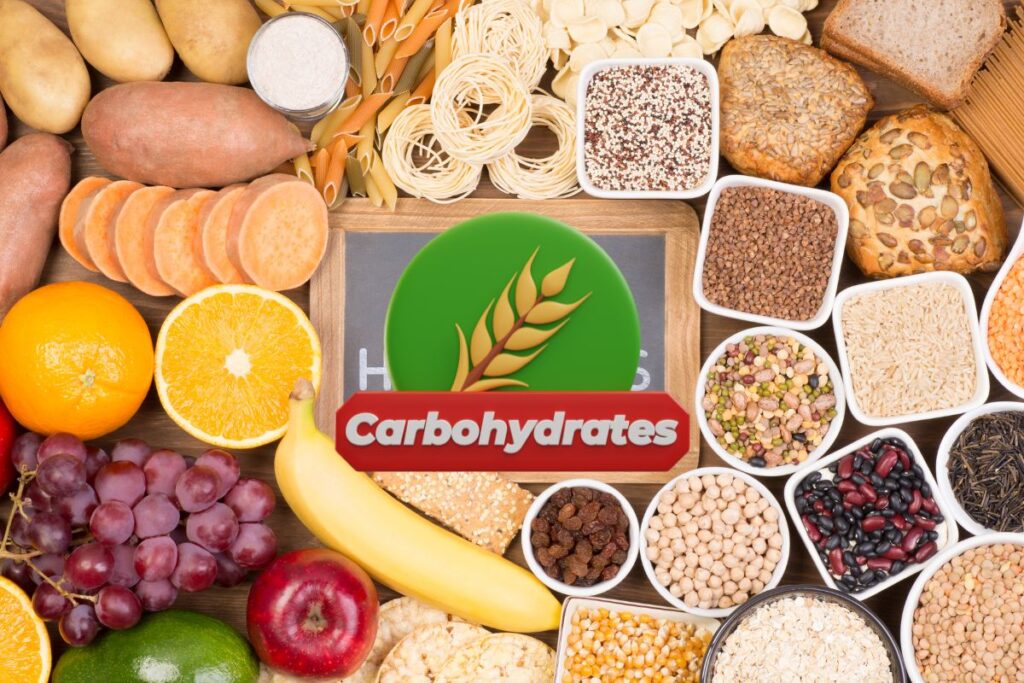
Carbohydrates are our body’s primary energy source, especially when we engage in vigorous exercises. They refill the muscles’ glycogen content that is consumed during a workout session. According to the Journal of Sports Sciences, consuming 3-5 grams of carbohydrates per kilogram of body weight daily is advisable to support muscle-building activities.
Importance of Carbohydrates for Muscle Building
Carbohydrates are very essential in muscle growth. While exercising, muscles make use of glycogen as their source of energy. Adequate carbohydrate intake helps restore these glycogen levels and sustain energy over long durations, thus facilitating optimal performance. Research reveals that carbohydrate ingestion enhances muscle repair and hypertrophy by providing necessary fuel during intense workouts.
Sources of Carbohydrates
To meet your carbohydrate needs, include these high-quality key sources in your diet:
- Whole Grains, such as brown rice, quinoa, oats, and whole wheat bread, provide complex carbs and fiber. For instance, 100 grams of quinoa offers 21 grams of carbohydrates, supporting sustained energy levels.
- Fruits like bananas, apples, and berries offer quick energy and essential vitamins. A medium banana contains about 27 grams of carbohydrates, making it an excellent option for a pre-workout boost.
- Vegetables, including sweet potatoes, broccoli, and spinach, supply vital nutrients and fiber for overall health. One medium sweet potato provides approximately 23 grams of carbohydrates, supporting energy and recovery.
- Legumes, such as beans, lentils, and chickpeas, offer substantial carbohydrates and protein. One cup of cooked lentils contains around 40 grams of carbohydrates, making them nutritious for balanced energy.
Healthy Fats
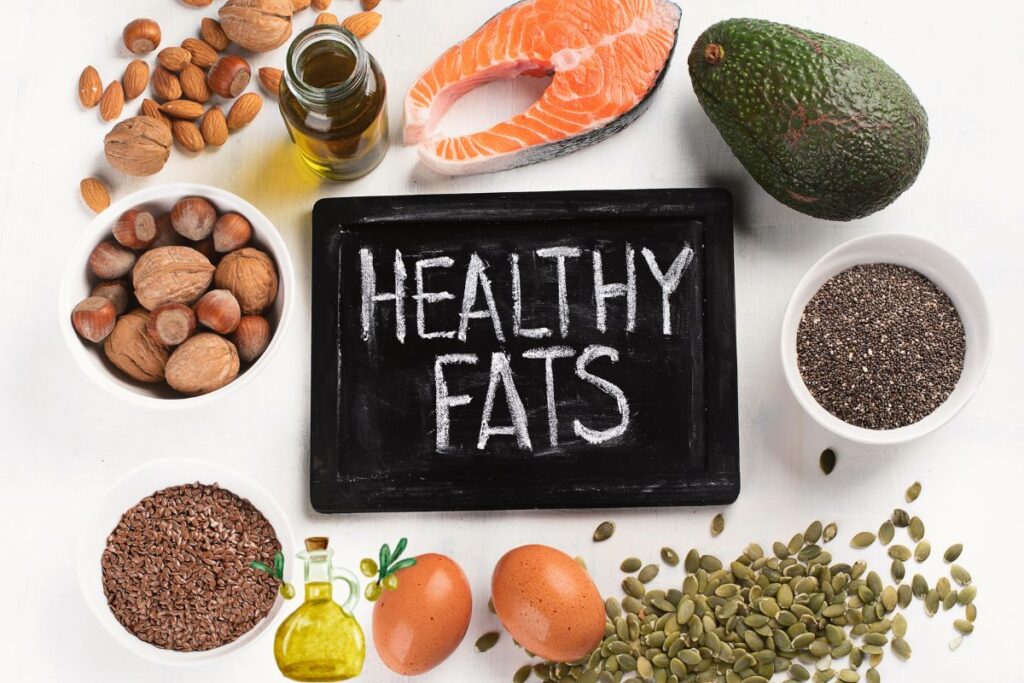
Healthy fats are essential for muscle development and overall health. They support hormone synthesis, including testosterone, which is key in muscle building. They also act as an energy source and facilitate the absorption of fat-soluble vitamins. To enhance muscle-building and overall health goals, include 20-30% fats in your total calorie intake.
Sources of Healthy Fats
These are some sources of Healthy Fats.
- Avocados are rich in monounsaturated fats, potassium, and vitamin K. These fats support hormone production and overall health.
- Nuts, such as almonds, walnuts, and cashews, offer healthy fats and protein. These nuts contribute to muscle repair and energy.
- Olive oil is a heart-healthy fat used in cooking or as a salad dressing. It provides monounsaturated fats that support cardiovascular health.
What to Avoid
Limit intake of saturated fats and trans fats, which can increase the risk of chronic diseases and hinder muscle growth. These are found in processed foods and excessive animal fats.
Vitamins for muscle building
Vitamin D is essential for muscle function and growth by increasing calcium absorption, which helps muscle contraction. Sunlight provides about 1,000 IU of vitamin D in just 15 minutes. Oily fish, such as salmon, provide about 1,000 IU per 3.5 ounce serving. Vitamin B12 boosts energy and aids protein synthesis by supporting red blood cell production. Beef liver contains up to 70 micrograms per 3.5 ounces, exceeding the daily requirement of 2.4 micrograms. Vitamin C acts as an antioxidant, reduces tissue damage and stimulates collagen production for repair. A medium-sized orange provides about 70 milligrams, in line with recommended daily recommendations.
Vitamin E protects tissues from oxidative stress and inflammation, and almonds provide about 7.3 milligrams per ounce, close to the 15-mg daily requirement Vitamin A supports protein synthesis and cell growth, which is essential for tissue repair . The liver provides 9,000 IU per 3.5 ounces, far more than the daily allowance of 3,000 IU for men and 2,300 IU for women. Proper intake of these vitamins promotes muscle function, growth and recovery.
Exercises for Muscle Building
After focusing on your diet, it’s time to get into exercises that will fuel your muscle growth.Exercise drives muscle growth by stimulating muscle hypertrophy, where muscle fibers increase in size. To build muscle effectively, perform the right exercises and follow a structured routine. This approach helps your muscles grow efficiently. By using effective fitness tips in your workout, you can achieve better results and build muscle more effectively. Here’s how you can build muscle with exercises.
Essential Muscle-Building Exercises
Strength Training is a crucial component of muscle building. It involves exercises that target specific muscle groups to increase muscle mass and strength. Compound movements are particularly effective because they engage multiple muscles simultaneously, promoting overall growth and efficiency. These exercises must form the foundation of any workout routine to build muscle. Below are the essential compound exercises and their benefits.
Squats

As you can see in the image, the man performing squats is targeting the quadriceps, hamstrings, glutes, and core. Squats improve lower body strength and contribute significantly to overall muscle mass. To perform squats, stand with your feet shoulder-width apart, lower your hips back and down as if sitting on a chair, and then rise back up. Squats are a key exercise for developing powerful legs and improving balance and coordination. For example, doing 3 sets of 8-12 reps of squats can significantly improve leg strength and overall body stability.
Deadlifts

Deadlifts focus on the hamstrings, glutes, lower back, and traps. Deadlifts improve strength and muscle growth in the entire posterior chain, which includes muscles that run along the backside of your body. To execute a deadlift, stand with your feet hip-width apart, grip the barbell, lift it while keeping your back straight, and lower it back down. Deadlifts improve functional strength and are crucial for building a robust physique. Lifting weights approximately 70-80% of your one-rep max (1RM) in 3 sets of 6-8 reps effectively promotes muscle hypertrophy.
Bench presses
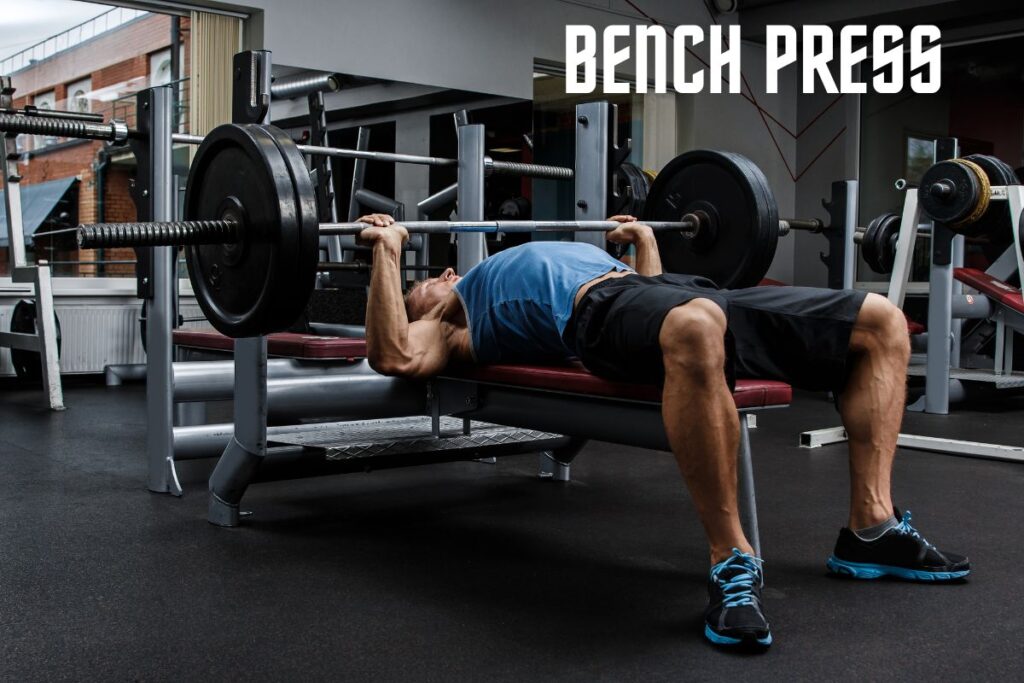
Bench Pressest targets the chest, triceps, and shoulders; this exercise improves upper body strength and muscle hypertrophy. To perform a bench press, lie on a bench, grip the barbell slightly wider than shoulder-width, lower it to your chest, and press it back up. This exercise is excellent for developing a muscular upper body and improving pushing power. Bench pressing weights around 75% of your 1RM for 3-4 sets of 8-10 reps can lead to significant muscle gains in the chest and arms.
Pull Ups

Pull-ups work the lats, biceps, and upper back. Pull-ups are excellent for building upper body strength and muscle. To do pull-ups, hang from a bar with an overhand grip, pull your body up until your chin is above the bar, and lower yourself back down. Pull-ups improve grip strength and enhance overall back and arm musculature. Performing 3 sets of 6-10 reps can significantly increase your back and arm strength.
Overhead Presses
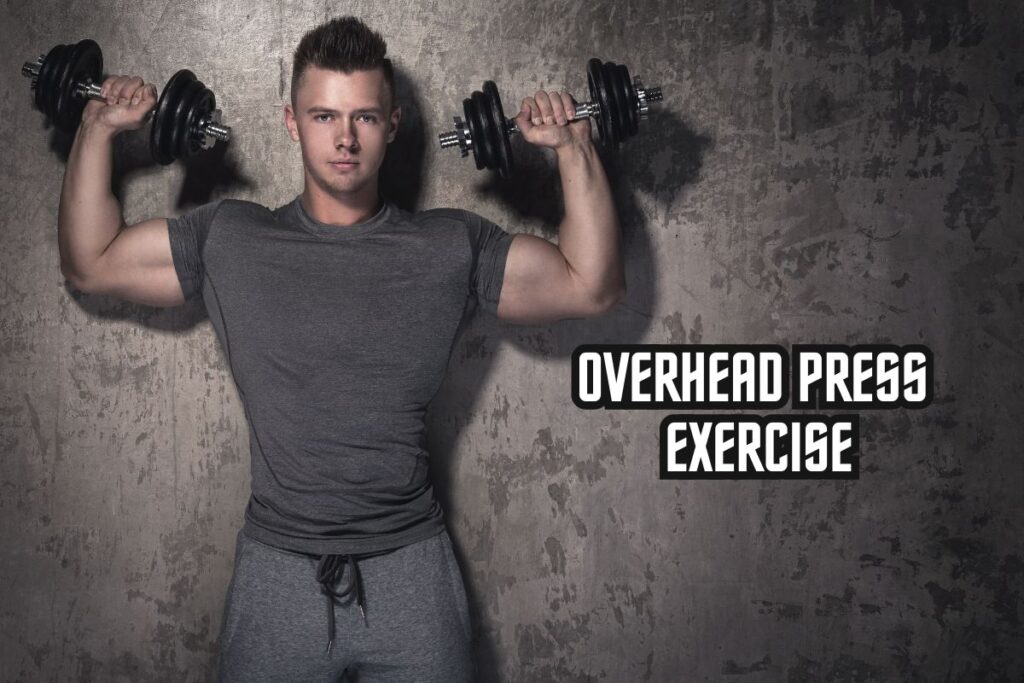
Overhead Presses target the shoulders, triceps, and upper chest. This exercise develops shoulder strength and overall upper-body stability. To perform an overhead press, stand with your feet shoulder-width apart, hold a barbell at shoulder height, press it overhead, and lower it back down. The overhead press is crucial for strengthening your shoulders and enhancing posture and stability. Using weights at 65-75% of your 1RM for 3 sets of 8-10 reps effectively builds shoulder muscle mass and strength.
Rows

Rows(Barbell or Dumbbell) engage the upper back, lats, and biceps. Rows improve upper back strength and promote muscle balance. To execute a row, bend over with a straight back, pull the barbell or dumbbells towards your torso, and lower them back down. Rows are key for improving pulling strength and building a balanced upper body. Performing 3 sets of 8-12 reps with weights about 70% of your 1RM can help strengthen the back and biceps.
Leg Presses
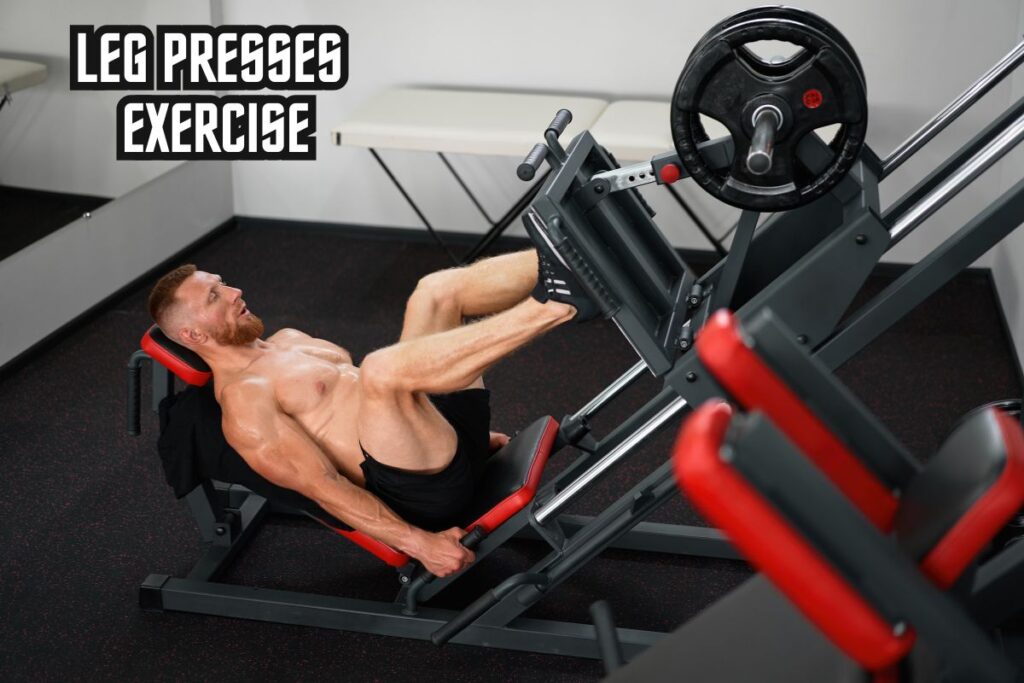
Leg Presses focus on the quadriceps, hamstrings, and glutes. Leg presses are great for targeting the lower body with controlled movement. To perform a leg press, sit on a leg press machine, press the platform with your feet, extend your legs, and slowly return to the starting position. This exercise helps in developing strong and muscular legs. Doing 3 sets of 10-15 reps with moderate weights can lead to significant gains in leg muscle and strength.
Isolation Exercises
Isolation exercises focus on individual muscles, allowing for specific development. These exercises are useful for addressing weaker areas and achieving balanced muscle growth. They help fine-tune muscle shape and definition by targeting muscles that may not receive enough attention during compound movements. Here are some key isolation exercises and their benefits:
Bicep Curls
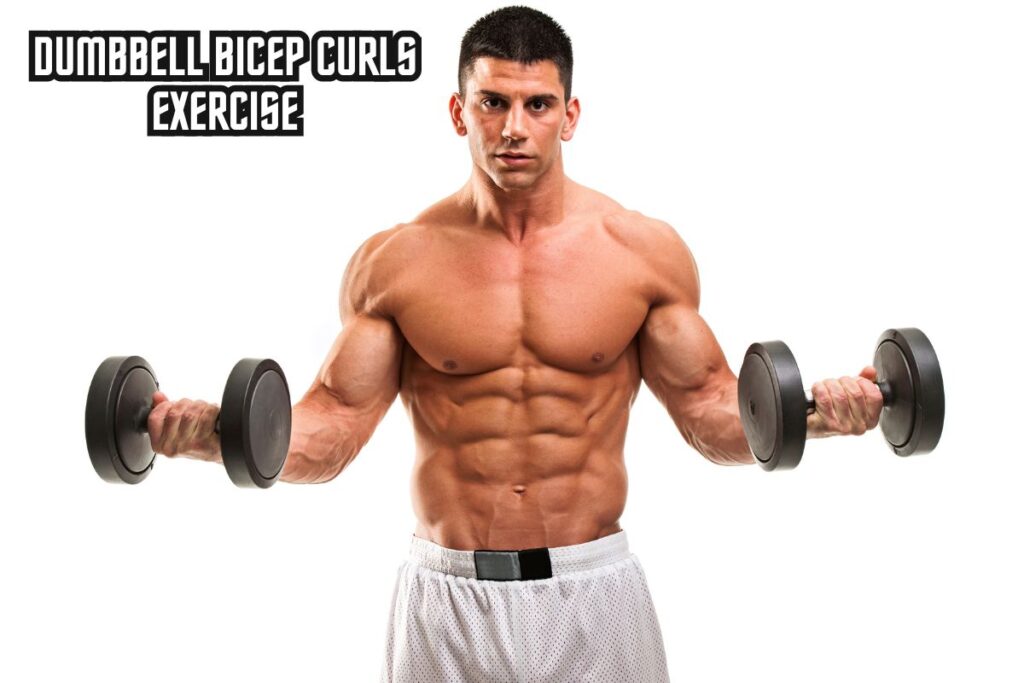
Bicep Curls target the biceps specifically, isolating them for targeted growth. To perform bicep curls, hold dumbbells at your sides, curl them up towards your shoulders, and lower them back down. This exercise is excellent for improving arm strength and sculpting well-defined biceps. Performing 3 sets of 10-15 reps with comfortable but challenging weights will result in significant bicep development.
Leg Extensions
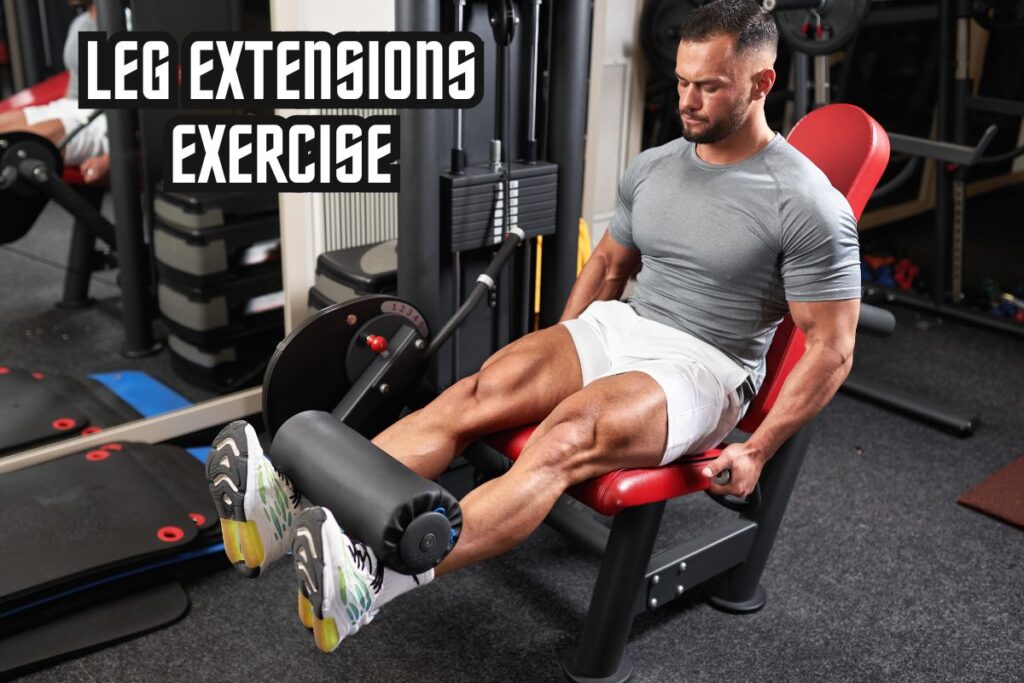
Leg extensions focus on the quadriceps, which helps define leg muscles. To execute leg extensions, sit on a leg extension machine, extend your legs, and then slowly return to the starting position. Leg extensions effectively isolate the quads, making them ideal for improving leg shape and endurance. Performing 3 sets of 12-15 reps effectively builds quadriceps muscle mass and improves definition.
Tricep Pushdowns
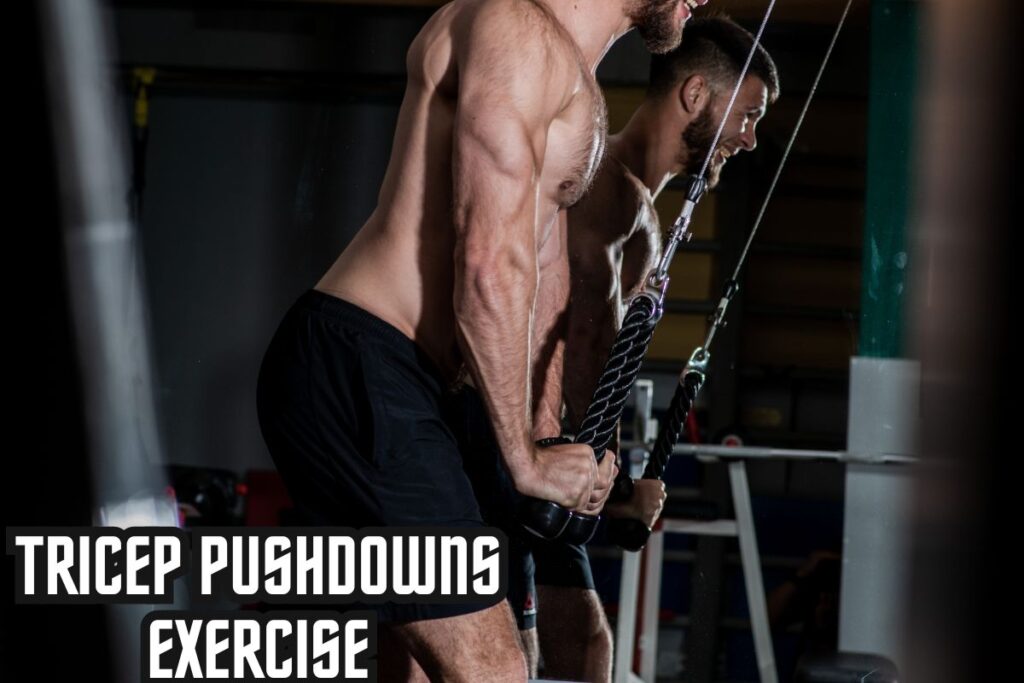
Tricep Pushdowns exclusively target the triceps for arm strength. To perform tricep pushdowns, stand at a cable machine, push the bar down towards your thighs, and then let it rise back up. This exercise is perfect for building tricep size and improving the overall appearance of your arms. Doing 3 sets of 10-12 reps can help build stronger and more defined triceps.
Effective Workout Strategies
For efficient muscle development, you will require a well-organized workout plan that targets all the major muscles of the body. You should aim for 3 to 6 training sessions per week as per your experience and objectives. If you are a novice, begin with three sessions, while experienced ones can go up to five or six sessions for better outcomes. Aim for 3-5 sets of 6-12 reps on each exercise because this range is best suited for hypertrophy, which promotes muscle growth. Every workout session should involve some exercises involving different muscles to ensure balance and prevent overtraining.
Adjust your plan as necessary to continue challenging your muscles using the progressive overload that allows constant growth as well as an increase in strength levels.
Sample Workout Plan
Here’s a sample 4-day workout plan focusing on building muscle mass.
- Bench Press 4 sets of 8-10 reps
- Bent-Over Rows 4 sets of 8-10 reps
- Shoulder Press 3 sets of 10-12 reps
- Pull-Ups 3 sets of 8-10 reps
- Tricep Dips 3 sets of 10-12 reps
- Squats 4 sets of 8-10 reps
- Deadlifts 4 sets of 8-10 reps
- Leg Press 3 sets of 10-12 reps
- Lunges 3 sets of 12-15 reps
- Calf Raises 3 sets of 15-20 reps
- Rest
- Hydration
- Light Stretching
- Yoga
- Barbell Squats 4 sets of 8 reps
- Bench Press 4 sets of 8 reps
- Pull-Ups 3 sets of 10 reps
- Overhead Press 3 sets of 12 reps
- Plank Holds 3 sets of 60 sec
Importance of Proper Form
During muscle building, exercise is important, but performing exercises with correct forms should be the priority. In fact, you need to use proper form when exercising to avoid injuries and fully activate your muscles. Controlled movements are key; focusing on slow, intentional movements instead of speed helps maintain muscle tension and increase efficiency. Correct posture and alignment are vital during exercises as they ensure that the intended muscles are involved properly. Furthermore, getting help from spotters when lifting massive weights aids in avoiding accidents and giving more security.
This means keeping your back straight while lifting and not making jerky moves abruptly. Additionally, it promotes safe joint alignment while allowing efficient muscle action. During tough exercises, spotters act as a safety net and reduce the chance of injury, boosting confidence and morale.
Rest and Recovery

Rest and recovery are crucial components of muscle building. Muscles can’t recover fully without adequate rest, which impedes growth and performance. Do you know that Sleep plays an important role in muscle recovery? The National Sleep Foundation recommends that adults get 7-9 hours of Sleep each night to facilitate muscle repair and overall well-being. Quality sleep supports recovery by allowing muscles to rebuild and grow stronger.
Incorporate rest days into your weekly routine; they prevent burnout and ensure full muscle recovery. Take at least one rest day per week; it will help you maintain your performance and reduce the risk of injury. On rest days, engage in light activities such as walking, cycling, or yoga. These activities promote blood flow and aid recovery without adding muscle stress.
Hydration and Supplements
Hydration is vital for muscle function and overall health. The Institute of Medicine recommends drinking at least 3 liters of water daily to stay hydrated. Adequate hydration supports muscle performance and recovery. Supplements can also improve muscle-building efforts by providing essential nutrients. For example, protein shakes with 20-30 grams of protein are effective post-workout for muscle repair. Creatine, taken at 5 grams daily, improves muscle performance and increases lean muscle mass.
Common Mistakes to Avoid
One can avoid making common mistakes that hinder muscle growth. Overworking, which means spending more exercise time without enough rest, causes long-lasting tiredness, reduced performance, and mood shifts. To prevent these problems, take breaks a day for your body to recover and listen for the signs of the same in your system. Poor dieting habits like insufficient proteins or too much junk food suppress muscle growth. For muscular repair, balanced feeding should be maintained with adequate protein, carbohydrates, and fats.
Failure to use proper form raises the dangers of some injuries while reducing exercise effectiveness. The key here is to keep a correct posture and perform controlled movements. Always ask for help when lifting heavy weights so that you will not encounter accidents. Moreover, one may suffer from prolonged soreness and plateaued progress by not giving recovery the priority it deserves. Rest days and active recovery techniques should be included to ensure continuous muscle development.
Advanced Tips for Building Muscle
These advanced strategies will further improve your muscle growth. Periodization training involves varying training intensity and volume to prevent plateaus. Linear periodization gradually increases intensity while reducing volume, while undulating periodization varies intensity and volume weekly or daily. For instance, a 12-week cycle might start with high and low intensities, shifting to lower and higher intensities.
Time Under Tension (TUT) increases muscle hypertrophy by extending the time the muscles are under stress. Slow down the eccentric (lowering) and concentric (lifting) phases of exercises or incorporate pauses at peak contraction. For example, during a bench press, use a 3-second eccentric phase, a 2-second pause, and a 1-second concentric phase.
Supersets and drop sets are techniques that boost workout intensity and volume. Supersets involve performing two exercises back-to-back with minimal rest, targeting either opposing muscle groups or the same muscle. For instance, combine bicep curls with tricep extensions. Drop sets involve reducing the weight after reaching failure and continuing with lighter loads for additional reps, such as performing leg presses until failure, then decreasing weight and continuing without rest.
Functional training enhances overall strength and coordination, benefiting muscle growth. Exercises like kettlebell swings, medicine ball throws, and bodyweight movements improve power, endurance, and core stability. The mind-muscle connection involves consciously engaging muscles during exercises, leading to better muscle activation and growth. For example, focus on squeezing the biceps during curls to improve engagement.
Conclusion
Building muscle requires a balanced approach that integrates diet, exercise, rest, hydration, and supplementation. A well-structured workout plan and a diet rich in proteins, carbohydrates, and healthy fats form the foundation for muscle growth. Consistency in your routine and adequate rest and hydration are key to avoiding overtraining and ensuring effective recovery. Proper form during exercises maximizes results and minimizes injury risks. By staying committed and avoiding common pitfalls, you can achieve significant muscle gains, improve overall strength, and enhance your well-being. Embrace the journey with dedication, and you’ll build a stronger, healthier version of yourself.
Commonly Asked Questions
How Long Does It Take to See Muscle Growth?
If you are a beginner in strength training, seeing some muscle growth usually takes 8 weeks. For those with long-term experience, it can take between 3 and 4 weeks before any significant change is noticed. With consistent strength training and proper nutrition, most people can gain 1 to 2 pounds of lean muscle per month.
What are the best natural ways to build muscle without supplements?
To build muscle naturally, focus on a well-rounded diet that includes proteins, carbohydrates, and healthy fats. Regular strength training with compound exercises, staying hydrated, and getting enough rest are vital factors in promoting muscle growth.
How important is protein for muscle building?
Protein is vital in muscle building as it supplies the amino acids necessary for muscle repair and growth. For optimal muscle development purposes, an individual requires about 1.6-2.2g/kg protein intake daily, depending on his or her weight.
Can I build muscle at home without equipment?
Yes! You can build muscle at home using bodyweight exercises such as push-ups, squats, and lunges. Incorporating resistance bands into your routine can further enhance the effectiveness of your workouts.
How often should I train to build muscle effectively?
The frequency of your training should vary based on your experience level. If you are a beginner, start with three sessions per week, while those with more experience can train up to six times per week for optimal results.
What role do carbohydrates play in muscle building?
Carbohydrates are crucial for providing the energy needed for intense workouts and replenishing muscle glycogen stores. To support muscle growth, aim to consume 3-5 grams of carbohydrates per kilogram of body weight daily.
How much rest do I need between workouts for muscle recovery?
Muscles typically require about 48 hours to recover between intense workouts. Proper rest is essential to avoid overtraining and to facilitate muscle repair and growth.
What are some common mistakes that hinder muscle growth?
Overtraining, poor nutrition, neglecting proper form, and insufficient recovery time are common mistakes that impede muscle growth. It’s important to balance exercise techniques with adequate rest and nutrition.
How does hydration impact muscle growth?
Staying hydrated is essential for muscle function and recovery. Drink at least 3 liters of water daily to support muscle performance and overall health.





Comments are closed.